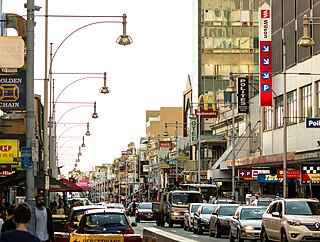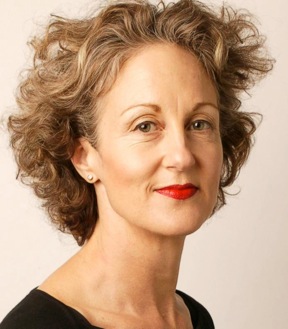Related Research Articles
Functional zoning, functional city zoning, or use-based zoning is a method used for dividing land use by its function. Typically, land use is divided in two ways, by its function and by its physical characteristics. An example of functional zoning would be an area that has designated zones based on a function such as an industrial zone, a recreational zone and a residential zone. An example of an area zoned by its physical characteristics is defined in terms of characteristics like development density, minimum lot size, and building coverage, placement and height.

Paley Park is a pocket park located at 3 East 53rd Street between Madison and Fifth Avenues in Midtown Manhattan, New York City, on the former site of the Stork Club. Designed by the landscape architectural firm of Zion Breen Richardson Associates, it opened May 23, 1967. Paley Park is often cited as one of the finest urban spaces in the United States.

Adelaide Festival Centre, Australia's first capital city multi-purpose arts centre and the home of South Australia's performing arts, was built in the 1970s, designed by Hassell Architects. Located on Kaurna Yarta, the Festival Theatre opened in June 1973 with the rest of the centre following soon after. The complex includes Festival Theatre, Dunstan Playhouse, Space Theatre and several gallery and function spaces. Located approximately 50 metres (160 ft) north of the corner of North Terrace and King William Road, lying near the banks of the River Torrens and adjacent to Elder Park, it is distinguished by its two white geometric dome roofs, and lies on a 45-degree angle to the city's grid.

Professor emeritus Hugh Stretton was an Australian historian who wrote books on politics, urban planning and economics, and a Rhodes Scholar. He was a key figure in the development and implementation of government policies affecting cities, particularly during the Whitlam government.
Paul Carter is a British academic and writer.

Hindley Street is located in the north-west quarter of the centre of Adelaide, the capital of South Australia. It runs between King William Street and West Terrace. The street was named after Charles Hindley, a British parliamentarian and social reformist.

Edmund William Wright was a London-born architect in the colony of South Australia. He was mayor of Adelaide for 10 months in 1859. He designed many civic, commercial, ecclesiastical, and residential buildings in Adelaide city centre and its suburbs, in styles influenced by French and Italian Renaissance, as well as Neoclassical architecture. He collaborated with other notable architects E. J. Woods, Isidor Beaver, and Edward Hamilton in designing some of the most notable buildings.

The Civic Trust Awards scheme is a British awards scheme to recognise outstanding architecture, planning and design in the built environment. It was established in 1959, and is the longest-standing built environment awards scheme in Europe. The Civic Trust Awards is not linked to any organisation, institution, or publication and operates on a not-for-profit basis. The general public is able to participate in nominating and judging schemes from their local area. They may also be awarded internationally.

The West Terrace Cemetery, formerly Adelaide Public Cemetery is a cemetery in Adelaide, South Australia. It is the state's oldest cemetery, first appearing on Colonel William Light's 1837 plan of the Adelaide city centre, to the south-west of the city. The whole cemetery is state heritage-listed, including Smyth Chapel, and it is one of the oldest operating cemeteries in Australia.
Grimshaw Architects is an architectural firm based in London. Founded in 1980 by Nicholas Grimshaw, the firm was one of the pioneers of high-tech architecture. In particular, they are known for their design of transport projects including Amsterdam Bijlmer ArenA railway station, Waterloo International railway station and the award-winning Southern Cross railway station which was the recipient of the Royal Institute of British Architects Lubetkin Prize. Grimshaw is behind the design of the Sustainability Pavilion, an innovative net-zero building, for Expo 2020. The firm currently has offices in Los Angeles, New York, London, Paris, Dubai, Melbourne and Sydney, employing over 600 staff.

Elizabeth Margaret Farrelly, is a Sydney-based author, architecture critic, essayist, columnist and speaker who was born in New Zealand but later became an Australian citizen. She has contributed to current debates about aesthetics and ethics; design, public art and architecture; urban and natural environments; society and politics, including criticism of the treatment of Julian Assange. Profiles of her have appeared in the New Zealand Architect, Urbis, The Australian Financial Review, the Australian Architectural Review, and Australian Geographic.
Hassell is a multidisciplinary architecture, design and urban planning practice with offices in Australia, China, Singapore, USA and the United Kingdom. Founded in 1937/8 in Adelaide, South Australia, the firm's former names include Claridge, Hassell and McConnell; Hassell, McConnell and Partners; and Hassell and Partners Pty. Ltd.

Meriton is an Australian property developer and construction company founded by Harry Triguboff AO, its managing director, in 1963. Meriton sells apartments and also operates serviced apartments accommodation under its Meriton Suites brand in Sydney, Brisbane and the Gold Coast.
The Melbourne Prize Trust is a charitable foundation in Melbourne, Australia. It was founded in 2004 by Simon Warrender Jnr for the specific purpose of awarding three arts award on a rotating three-year basis: the Melbourne Prize for Urban Sculpture, the Melbourne Prize for Literature, and the Melbourne Prize for Music. The first Melbourne Prize for Urban Sculpture was awarded in 2005.
The Adelaide University Union redevelopment (1967–1975), also known as the Union Building Group, is one of the most significant buildings in the University of Adelaide complex. It incorporates the existing buildings known as Union Buildings, Lady Symon Building, the George Murray Building, the Cloisters, and the Western Annexe, and created the new Union House.
Robert Harold Dickson was a South Australian architect. His many works contributed greatly to various aspects of South Australian architecture, ranging from conservation shelters to school buildings and residential projects. His most notable works are former premier, Don Dunstan's residence, the first townhouses in Adelaide and the University of Adelaide's Union House. He was described by Don Dunstan as the "premier architect".
Cindy Walters is an Australian architect and partner at Walters & Cohen in London, England.
The Melbourne Prize is an Australian architectural award. It is awarded annually at the Victorian Architecture Awards by a jury appointed by the Victoria Chapter of the Australian Institute of Architects to architectural projects that have made a significant contribution to the public life of Melbourne, Australia. It was first awarded in 1997 to Six Degrees Architects for the small bar Meyers Place.

Wentworth Memorial Church is a heritage-listed former Anglican church building located at 32B Fitzwilliam Road, Vaucluse, Sydney, Australia. It was designed by Clarke Gazzard and Partners and built by Monteith Constructions, with Miller Milston and Ferris as engineers. The property is privately owned; and was formerly owned by the Anglican Diocese of Sydney. It was added to the New South Wales State Heritage Register on 25 September 2012.

Janet Rosenberg, FCSLA, FASLA, IFLA, RCA, is a Canadian landscape architect based in Toronto, Ontario, Canada and the founding principal of Janet Rosenberg & Studio.
References
- ↑ Jones, David (1996). "The Civic Trust of South Australia: The community playing urban design watchdog". Australian Planner. 33 (3): 153–159. doi:10.1080/07293682.1996.9658101. ISSN 0729-3682.
- ↑ "Civic Trust of South Australia", Trove, 2008, retrieved 25 April 2024
- 1 2 "Nominate Australia's best (and worst) built projects for the 2018 Civic Trust Awards". ArchitectureAU . 17 April 2018. Retrieved 23 April 2024.
- 1 2 Tauriello, Giuseppe (23 November 2014). "Should we put a museum on the old RAH site?". adelaidenow. Retrieved 25 April 2024.
- ↑ Hiles, Darian. "Submission to: Economic Regulation of the South Australian Water Industry: Statement of Issues". Essential Services Commission of SA.
- ↑ "Home". Australian Civic Trust. Archived from the original on 8 March 2020.
- ↑ "Young, Gordon Research Collection". Architecture Museum, University of South Australia . Retrieved 25 April 2024.
- ↑ Lennon, Michael (2019). "A new framework for preserving our historic legacy and valued character" (PDF). Promotion. Department for Infrastructure and Transport.
- 1 2 "Civic Review 2019: Awards & Brickbats" (PDF). Australian Civic Trust. 13 November 2019. Archived from the original (PDF) on 12 March 2020.
- ↑ "Association Search". secure.cbs.sa.gov.au. Retrieved 26 May 2024.
- 1 2 3 4 5 "Awards". Swanbury Penglase. 10 July 2023. Retrieved 25 April 2024.
- 1 2 "Awards & Brickbats". Australian Civic Trust. Archived from the original on 8 March 2020.
- 1 2 "Awards". Shannon Architects. Retrieved 25 April 2024.
- ↑ McNamara, Lindy (26 February 2020). "Smyth Chapel project wins award". The Southern Cross. Retrieved 25 April 2024.